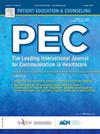在整个治疗过程中,根据成人脑癌患者不断变化的个体需求定制放化疗信息:范围综述
IF 3.1
2区 医学
Q2 PUBLIC, ENVIRONMENTAL & OCCUPATIONAL HEALTH
引用次数: 0
摘要
目的脑肿瘤患者的需求在整个放化疗过程中不断变化,因此需要个性化的信息和支持。提供可根据个人需求和偏好进行调整的定制信息,对于消除“一刀切”的风气和倡导真正以人为本的途径至关重要。方法采用预定义的纳入标准,对2003年至2023年间在Ovid MEDLINE、Embase、Emcare、EBSCO CINAHL和b谷歌Scholar上发表的文章进行综合检索,以确定关于为成人脑肿瘤患者提供个性化信息和支持的研究。创建了数据提取表,以促进对结果的叙述综合。归纳内容分析用于确定精细化的代码,以调整发现和讨论。结果共有9篇文章符合预定的纳入标准。从分析中产生了五个改进代码:1)目标信息;2)通过满足未满足的需求来改善患者的准备;3)使用适应性强的交付方法及时提供信息;4)改善医疗保健专业人员(HCP)与患者之间的关系;5)疾病轨迹的时间问题。结论研究结果表明,该领域仍有许多空白有待进一步探索。重点提出了一些重要建议,包括加深对个性化途径的了解、改善沟通、加强HCP培训和调整信息传递方法。在改善当前以人为中心的护理途径之前,需要解决总体系统挑战。实践意义引入适应性强的信息传递方法,包括扩展到远程医疗平台以收集实时患者洞察。加强HCP培训,在不同时间点提供更有针对性的信息。倡导改变有关劳动力能力和病人等待时间的政策。本文章由计算机程序翻译,如有差异,请以英文原文为准。
Tailoring chemoradiotherapy treatment information to the evolving, individual needs of adult brain cancer patients throughout the treatment trajectory: A scoping review
Objective
Brain tumour patients' needs evolve throughout the chemoradiotherapy pathway, thus requiring individualised information and support. Providing tailored information that is adaptable based on individual needs and preferences, is essential for eradicating the ‘one size fits all ethos’ and instigates a truly person-centred pathway.
Methods
A comprehensive search for articles published between 2003 and 2023 across Ovid MEDLINE, Embase, Emcare, EBSCO CINAHL and Google Scholar using pre-defined inclusion criteria, was conducted to identify studies that reported on the provision of tailored information and support to individual need in adult brain tumour patients. Data extraction tables were created to facilitate a narrative synthesis of the results. Inductive content analysis was used to determine refined codes to tailor the findings and discussion.
Results
In total, nine articles met the pre-defined inclusion criteria. Five refined codes emerged from the analysis: 1) targeting information, 2) improving patient preparedness by meeting unmet needs, 3) timely information using adaptable methods of delivery, 4) improving relationships between healthcare professional (HCP) and patient and 5) a question of timing across the disease trajectory.
Conclusion
Findings indicate that there are many gaps to be further explored. Developing a richer understanding of personalised pathways, improving communication, strengthening HCP training, and adapting information delivery methods are some of the key recommendations highlighted. Overarching systemic challenges need to be addressed before current person-centred care pathways can be improved.
Practice implications
To introduce adaptable delivery methods for information, including expansion into telehealth platforms to collect real-time patient insight. To strengthen HCP training to deliver more tailored information at varying timepoints. To advocate for policy change regarding workforce capacity and patient waiting times.
求助全文
通过发布文献求助,成功后即可免费获取论文全文。
去求助
来源期刊

Patient Education and Counseling
医学-公共卫生、环境卫生与职业卫生
CiteScore
5.60
自引率
11.40%
发文量
384
审稿时长
46 days
期刊介绍:
Patient Education and Counseling is an interdisciplinary, international journal for patient education and health promotion researchers, managers and clinicians. The journal seeks to explore and elucidate the educational, counseling and communication models in health care. Its aim is to provide a forum for fundamental as well as applied research, and to promote the study of organizational issues involved with the delivery of patient education, counseling, health promotion services and training models in improving communication between providers and patients.
 求助内容:
求助内容: 应助结果提醒方式:
应助结果提醒方式:


